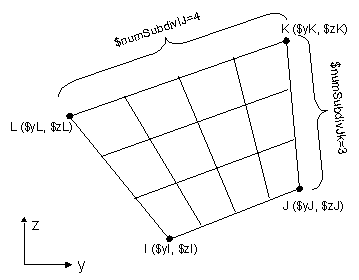This command is used to construct a Patch object with a quadrilateral shape. The geometry of the patch is defined by four vertices: I J K L, as illustrated in the Figure. The coordinates of each of the four vertices is specified in sequence -- counter-clockwise.
patch quad $matTag $numSubdivIJ $numSubdivJK $yI $zI $yJ $zJ $yK $zK $yL $zL
$matTag |
material integer tag of the previously-defined UniaxialMaterial object used to represent the stress-strain for the area of the fiber |
|
$numSubdivIJ |
number of subdivisions (fibers) in the IJ direction. |
|
$numSubdivJK |
number of subdivisions (fibers) in the JK direction. |
|
$yI |
$zI |
y & z-coordinates of vertex I (local coordinate system) |
$yJ |
$zJ |
y & z-coordinates of vertex J (local coordinate system) |
$yK |
$zK |
y & z-coordinates of vertex K (local coordinate system) |
$yL |
$zL |
y & z-coordinates of vertex L (local coordinate system) |
NOTE: in 2D bending is about the local z-axis
EXAMPLE:
patch quad $coreMatTag 8 8 -$b -$h $b -$h $b $h -$b $h; # define core patch with 8 subdivisions within a rectange of width 2b and depth 2h
